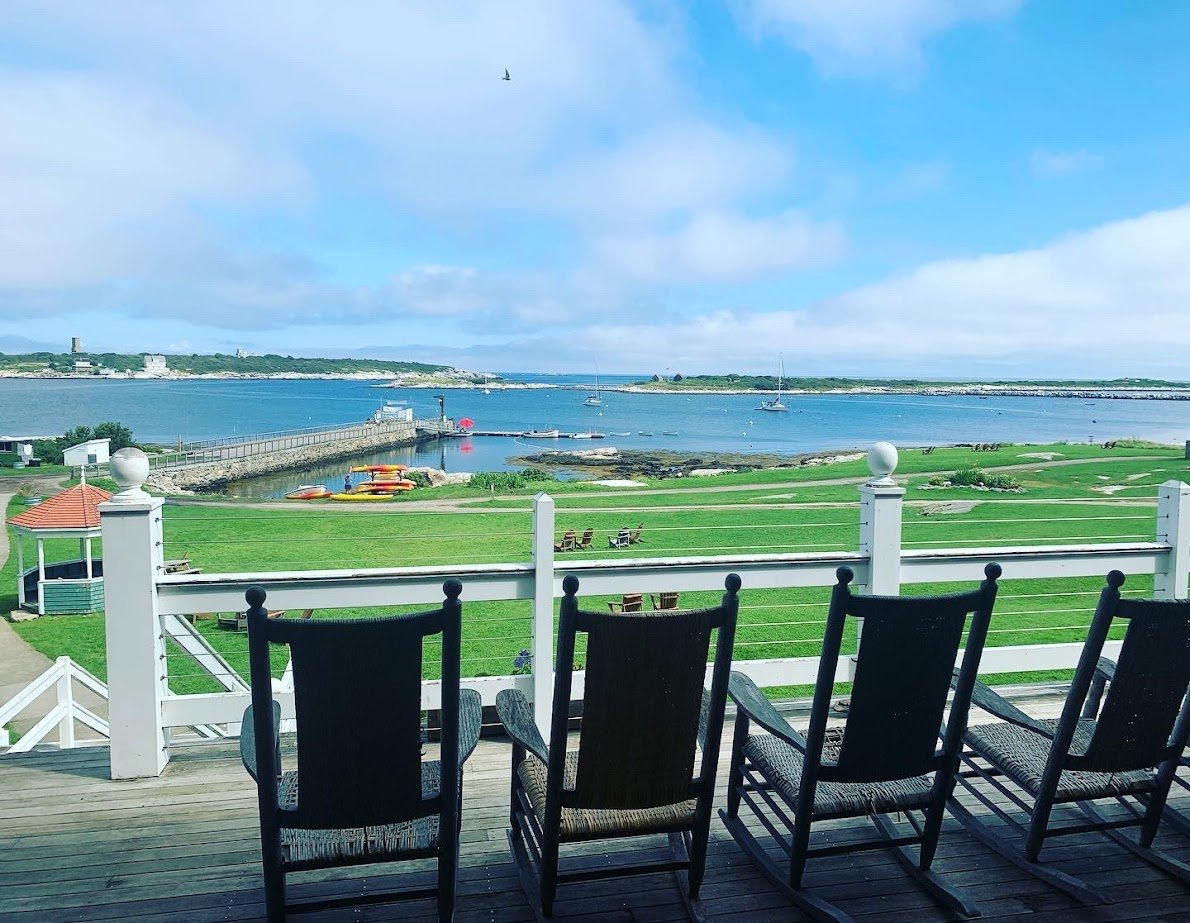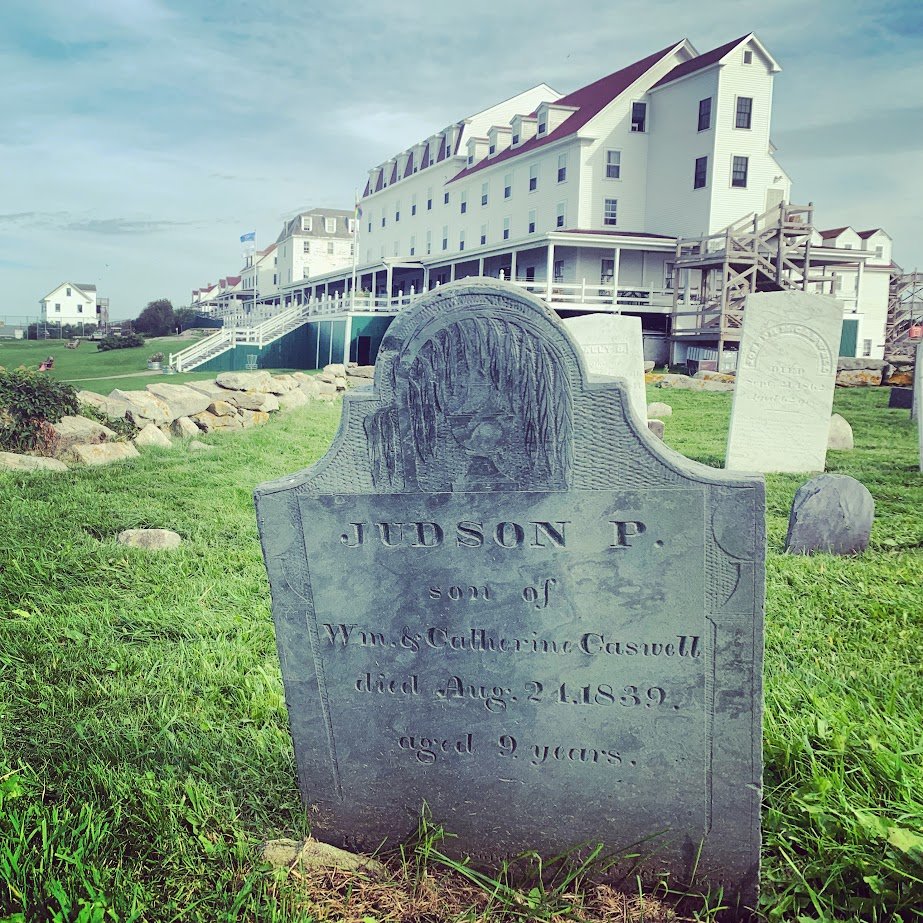"Demoralized, Intemperate, and Vicious": Saving Star Island Souls
/by Bethany Groff Dorau, Executive Director
Well, friends, another two weeks just flew by. Life races along at break-neck speed these late-summer days. Two weeks ago, before the kids went back to school, before the leaves on the maple tree on the lane began to hint at the red and gold to come, I was invited to speak at the New England Heritage Conference on Star Island on the Isles of Shoals. I could only get away from work, farm, and family responsibilities for one night, but I squeezed every drop from the experience, going out on the early morning boat on Monday and returning on the last boat Tuesday. I am a bit obsessed with the Isles of Shoals, I admit, though I’m not entirely sure when this passionate attachment began. Could it be the worn copy of Among the Isles of Shoals by Celia Thaxter on my grandmother’s bookshelf? A romantic longing for solitude and the sea? Whatever it is, there is no cure. I am smitten.
And, of course (and why would I be surprised), Newbury(port) is everywhere on the Isles of Shoals. First, I ran into Bob Cook, a garrulous architect who used to give fabulous tours with me at the Coffin House, and his sister, Amy, who convinced me to jump in the ocean shortly after sunrise the next morning. And then, there was Laurie, my friend for many Newburyport years and now helping to raise the Star Island Corporation to new fundraising heights. It was Laurie that said it first. “Newburyport follows me around,” she said, laughing. “Go read that monument over there.”
The Tucke Memorial is the largest gravestone in New Hampshire at 46.5 feet.
Across the wild roses and low bush blueberries, rose an obelisk, black against the grey-blue sky. “Go look,” she said, and floated away. Everyone seems lighter on the island. I floated up the boulder-strewn path, past the stone chapel with its pump organ, through the turnstile, exclaiming in delight at every little bit of it. And there, on top of the island, stood what I later learned is the largest gravestone in New Hampshire, atop the mortal remains of Reverend John Tucke, who became the minister to Gosport, the name of the town on Star Island, in 1732. One side of the obelisk was a wall of words.
Underneath
are the Remains of the
REV. JOHN TUCKE, A. M.
He graduated at Harvard
College A. D. 1723, was ordained
here July 26, 1732,
and died late in August, 1773,
Aet. 71.
---
He was affable and polite in his
Manner, amiable in his disposition,
of great Piety and Integrity,
given to hospitality,
Diligent and faithful in his
pastoral office, well learned
in History and Geography as
well as general science, and a
careful Physician both to the
Bodies and the Souls
of his People.
---
Erected 1800 in memory of the Just.
---
The inscription above is taken from
the sandstone slab placed over the
grave of the Rev. John Tucke
by Dudley A. Tyng of Newburyport, Mass. (emphasis my own)
---
In 1914 a kinsman,
EDWARD TUCK,
renewed in permanent form
this memorial.
“Dudley Tyng of Newburyport, Mass,” on the Tucke memorial.
And so, like so many of you, I had myself a bit of a chin-scratch. What in the blue blazes was Newburyport’s customs officer Dudley Tyng doing erecting monuments to ministers on obscure islands in the middle of the sea in 1800? Now, Dudley Tyng is a story all by himself. Born Dudley Atkins, he changed his name to Tyng (which was once spelled THING) in order to qualify for a whopping great inheritance from his third cousin. Apparently, as Newburyport customs agent, he had dealings with, and heard stories about, Star Island’s “demoralized, intemperate, and vicious” fishermen who were “living in open violation of the laws of God and man”. These were the people who had repopulated the island after it was evacuated at the start of the American Revolution, not the formerly pious congregation of Rev. Tucke.
Dudley Atkins Tyng, painted by Gilbert Stuart, c. 1810
And so, Tyng first told these Shoalers to lay off the booze and “curb their evil passions and appetites”, and then he called his other wealthy friends and put together a spiritual first aid team to put things to right on the lawless neighbors to the north.
Tyng appealed to the Society for Propagating the Gospel Among Indians and Others in North America, who dispatched a missionary to the island in April, 1799, and Tyng went on a fundraising tour around New England with his equally fervent buddy Rev. Jedidiah Morse, another Newbury descendant, to raise money for a new church. Tyng arrived on the island on October 20, 1800 with materials and 14 carpenters and the church was built, and some island houses repaired, in less than 10 days.
Perhaps most importantly for our purposes, he tripped over the body of the community’s long-time minister, John Tucke, dead since 1773. Okay, he tripped over Tucke’s disintegrating grave marker, but the effect was the same. Tyng, never one to pass up the opportunity to make a moral message stick, erected the sandstone tablet mentioned in the current marker to remind the rag-tag residents that Star Island had once been a Christian community.
Yours truly relaxing in front of the church that Tyng built in 10 days in 1800.
Star Island had long been a part of Rye, New Hampshire, but in 1715, it was established as the town of Gosport, and since a town had to have a minister at the time, lucky John Tucke got the job – to be paid in fish. Now, before you start feeling bad for Tucke, the fish paychecks were valuable and he did quite well for himself, being considered at one time to be the highest paid minster in New Hampshire (some say New England). Gosport was a busy, if tiny, town, and during his long four decades on the island, he managed to baptize some 700 babies. He died, conveniently, just before the American Revolution, and the evacuation of the Isles of Shoals, from which the town of Gosport never quite regained its spiritual footing, at least not enough to satisfy old Dudley Atkins Tyng. The 19th century in the Isles is a catalogue of murder, stand-offs, isolation, and, well, okay, thanks to Celia Thaxter, gardening, poetry, and art.
I must say that the lawlessness on Star Island these days seems to be kept to a minimum, though there were boxes of wine on the porch in the late afternoon. I did wonder as I sat on the sprawling porch of the Oceanic Hotel, what Dudley Tyng would think of the laughing day-trippers pouring out of the ferry Thomas Leighton. Would he meet them on the pier with his Bible? Or would he sit with me in a rocking chair and consider all the laughing, gentle people around us, the affirmations written on the blackboard in the lobby, the volunteers lovingly re-caning the dining room chairs, and think that Star Island turned out to be a sacred place, after all.









